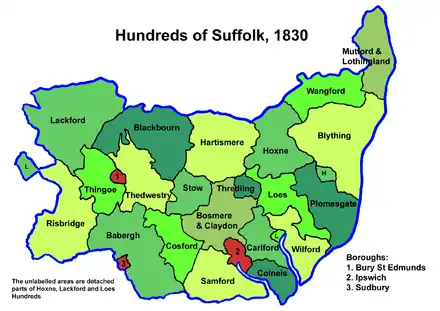Hundreds of Suffolk
The county of Suffolk was divided into hundreds between Saxon times and the 19th century, when they were replaced for administrative purposes by districts.

In 1831 the county was subdivided into twenty-one hundreds and three municipal boroughs.[1][2] The majority of these hundreds had remained unchanged since the time of the Domesday Survey, except that in 1086 Babergh was listed as two hundreds, Cosford, Ipswich and Parham as half hundreds and Samford as a hundred and a half.[1] Hoxne hundred was then known as Bishops hundred[3] and the vills which were included later in Thredling hundred were within Claydon hundred.[1]
List of hundreds (1831)
| Hundred | Area (acres) |
|---|---|
| Babergh | 70632 |
| Blackbourn | 66272 |
| Blything | 87631 |
| Bosmere-and-Claydon | 48773 |
| Carlford | 25461 |
| Colneis | 16712 |
| Cosford | 30712 |
| Hartismere | 53479 |
| Hoxne | 55648 |
| Lackford | 83712 |
| Loes | 31321 |
| Mutford and Lothingland | 33368 |
| Plomesgate | 41579 |
| Risbridge | 58468 |
| Samford | 44940 |
| Stow | 22710 |
| Thedwestry | 40362 |
| Thingoe | 31850 |
| Thredling | 10000 |
| Wangford | 34679 |
| Wilford | 31500 |
In addition the county contained three boroughs, corresponding to the county's largest towns:
| Borough | Area (acres) |
|---|---|
| Bury St Edmunds | 3040 |
| Ipswich | 8450 |
| Sudbury | 1250 |
References
- Chisholm, Hugh, ed. (1911). . Encyclopædia Britannica. 26 (11th ed.). Cambridge University Press. pp. 28–29.
- "Suffolk Hundreds". UK & Ireland Genealogy.
- Open Domesday: Bishop's Hundred, accessed February 2020.
This article is issued from Wikipedia. The text is licensed under Creative Commons - Attribution - Sharealike. Additional terms may apply for the media files.
